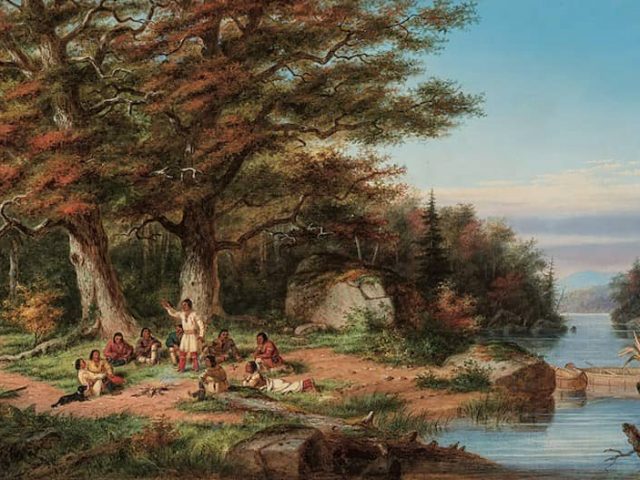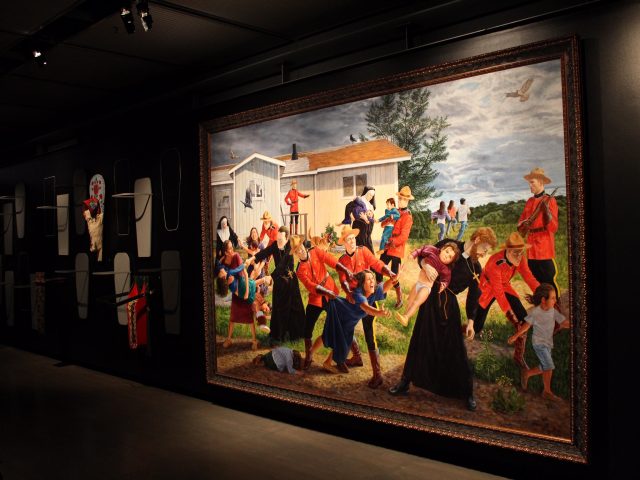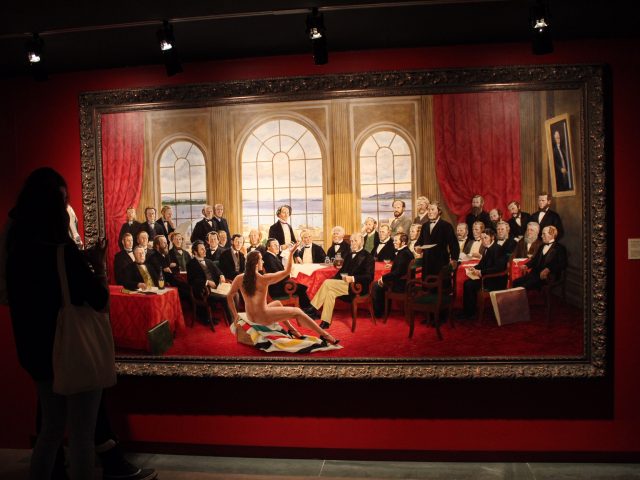Fisher River Cree artist Kent Monkman inspired a sold out audience at McGill’s Pollock Hall the night of February 6th with a behind-the-scenes look into his artistic practice. The artist’s lecture was presented by the McCord Museum, in collaboration with McGill University’s Visual Arts Collection (Library), and with support from the Office of the Provost and Vice-Principal (Academic) and the Department of Art History and Communication Studies.
In dialogue with his recently unveiled exhibition at the McCord, Shame and Prejudice: A Story of Resilience, the artist described his modern atelier, complete with iPads and as many as 12 studio assistants. The traveling exhibition is on view at the McCord Museum until May 5, 2019, and was curated by Monkman and his collaborators. Originally at the Art Museum of the University of Toronto, it makes for an immersive viewing experience replete with time- and gender-bending history paintings and thought provoking installations. Monkman’s timely critiques of Canadian settler-colonialism incorporate humour and blend sexuality and tragedy to counter the historic misrepresentation of Indigenous peoples in the Canadian art historical canon.
Monkman explained during his talk that he has been “moving paint” around since the age of five. He began his career by exploring abstraction but eventually focused on figural depictions of lived Indigenous experience, no longer finding abstraction a meaningful conduit for his Indigenous and queer perspective. The artist currently takes inspiration from the works of settler artists like George Catlin, Cornelius Krieghoff, and Paul Kane. Their often-imagined renderings of Indigenous peoples in the Canadian wilderness misinformed the settler public about Indigeneity for generations, perpetuating the harmful stereotype of a timeless, pre-contact, and homogeneous Indigenous culture (Fig. 1). To correct this and, as he says, “authorize Indigenous experiences,” Monkman has his omnipresent alter-ego, Miss Chief Eagle Testickle, guide visitors through nine narrated chapters, written from Miss Chief’s perspective and displayed on the museum’s walls as gallery text. Functioning as a parody of artists who paint themselves into their own artworks, Miss Chief, a self-described two-spirited, time-traveling trickster, provides historical context for the works and installations. In some cases, Miss Chief is left speechless and the wall labels nearly blank, as next to Monkman’s highly affective work The Scream, a frank and wrenching representation of the forcible removal of Indigenous children and the residential school system (Fig. 2).
Visitors will be pleased to encounter a few of Monkman’s most famous paintings, like The Daddies, which parodies Robert Harris’ iconic painting of Canada’s founding fathers (Fig. 3). Monkman pictures the founding fathers as a gawking cohort of bug-eyed men instead of the stoic personalities depicted by Harris in 1884. In Monkman’s rendition, the daddies lecherously drink in Miss Chief’s reclining nude body. This scene will likely be familiar to every Canadian who visits the exhibition. Several other works push the boundaries, specifically, of Quebec’s local understanding of Indigenous history. As the mood shifts from humorous depictions of confederation to darker portrayals of the more recent horrors of the residential school system and Indigenous incarceration, Monkman draws on the specific realities of the Plains Cree.
Throughout the exhibition, Monkman takes inspiration from the lives of Pitikwahanapiwiyin (Poundmaker) and Mistahimaskwa (Big Bear), hereditary chiefs who refused to sign Treaty 6 in 1876 and became involved in the Northwest rebellion in 1885. Showcasing Poundmaker’s moccasins, archival photographs of his imprisonment, and the shackles used to incarcerate Indigenous resistors, Monkman points to the ongoing nature of Indigenous resistance to state-enacted violence.
Searching for ways to turn an ugly history into something beautiful, Monkman and Miss Chief walk viewers through a century and a half of colonialism. The result is at once humorous, horrific, surprising, cathartic and, above all, moving. On the heels of last year’s celebrations for Canada 150, Shame and Prejudice compels us to reconsider our shared history, reframing the last century and a half as, in Monkman’s own words, “the most devastating period for First Peoples.”
-Written by Hannah Deskin, Museum Database Assistant, Visual Arts Collection















Leave a Reply
You must be logged in to post a comment.